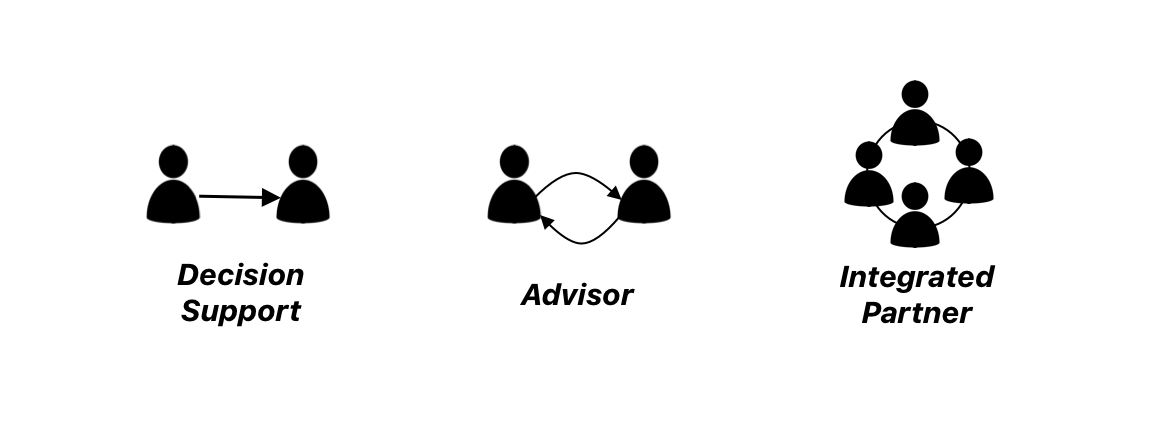One of the best and worst parts of being a data scientist is the ambiguity that the role can often entail. Since data science is a relatively new function, the mandate and objectives aren’t always clear. This often means that the destiny of data science at a company lies in the hands of the data scientists, who often find themselves straddling both technical and non-technical domains. As such, being able to shape and define the role is key if you want to have a fulfilling career as a data scientist.
In this article, we’ll explore the progression that a data scientist makes throughout their career, starting with Decision Support, Advisor and then Integrated Partner. We’ll go over their characteristics, some examples, and how you can progress through each stage.
Decision Support
The dynamic that you have at the decision support stage is similar to a ticketing system, where you’re fulfilling requests with simple data extracts and leaving insights to the stakeholder. At this stage, the relationship you have with your stakeholders is subservient. You’re unlikely to push back or provide input on what you should be working on or what the company as a whole should focus on. The work is reactive, and your roadmap consists of whatever your stakeholders are asking for that week.
Advisor
The advisor, on the other hand, acts as a thought partner. Instead of receiving and fulfilling requests, advisors take the time to understand the problem and reframe the request when necessary. Sometimes this means taking simple data requests and turning them into more substantial projects with recommended action plans. This type of work is semi-reactive, where you still have your roadmap primarily set by stakeholders, however, it begins to take on a collegial tone where you negotiate the terms of the engagement. You’re no longer fulfilling requests unquestioningly, but rather creating a dialog with your stakeholders where you’re able to learn from one another and figure out what the priorities should be.
Integrated Partner
As an integrated partner, the data scientist helps craft the strategic vision for the organization and has an active hand in creating the data science roadmap. To reach this stage requires deep expertise, not just in technical techniques and data, but also in the business and the politics of your company. It also means learning to spot opportunities and proactively working on projects which drive action and results in partnership with your stakeholders. This requires a high degree of empathy, being able to put yourself in the shoes of your stakeholders, and understanding the incentives that drive them.
At this stage you can actually set a roadmap and work towards it. You’re able to balance the needs of your stakeholders, with what’s most important based on what you agreed upon. Saying no to requests comes easily to an integrated partner, because they’ve already built trust and received buy-in from their stakeholders on what the priorities should be.
Integrated partners are also more likely to challenge stakeholders on opinions they hold rather than assuming that they’re always correct. Steve Jobs was famous for cultivating a culture of debate, seeing it as a prerequisite to generating great ideas. Being the gatekeeper of the data, you have a responsibility to provide your unique point of view instead of staying silent.

It’s important to recognize the fluidity of these stages. Having an integrated partner dynamic at all times with all your stakeholders can be taxing. Sometimes it’s easier to simply provide a data extract, than to try to unpack the reason behind the request. However don’t get into the habit of doing this, or you may find yourself stuck in this mode with minimal influence within the organization.
To build influence and transition through each stage requires you to go beyond understanding data. It requires building coalitions with stakeholders that are data savvy, and helping to convert those that are not as data inclined.
It also means occasionally opting for a non-elegant solution which secures a quick win and establishes credibility, rather than a multi-month research project that’s unlikely to yield substantial results. Spending some time building an aggregate table and visualizing it in Tableau can buy a lot of goodwill and credibility with your stakeholders. This can then directly translate to future projects that wouldn’t have succeeded without the support from your stakeholders.

In summary, the data scientists that are able to have the most impact, are the ones that have a deep expertise and are plugged into the wider company. They’re able to exercise influence across verticals and create coalitions to accomplish broad strategic objectives, regardless of the technical methods they employ.
